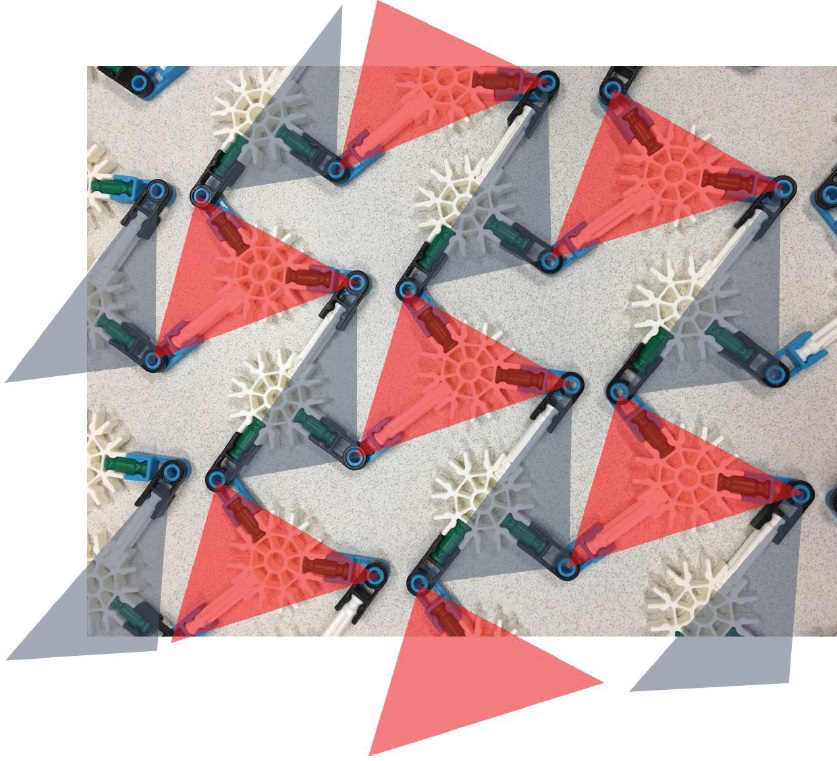Variable-hardness materials
Dr. Neil Canter, Contributing Editor | TLT Tech Beat April 2017
A newly designed material can switch reversibly between different degrees of hardness.
KEY CONCEPTS
•
Metamaterials are materials produced in a certain manner to exhibit properties needed for specific applications.
•
A newly designed transformable topological mechanical material can transform from being soft to being hard and then revert to being soft.
•
One application for transformable topological mechanical material is as an automotive bumper or outer-body structure.
THE CONTINUING DEMANDS for machinery that operates under a wide range of extreme conditions for long periods and exhibits excellent efficiency is continuing. One approach for meeting this goal is lighter-weight materials.
In a past TLT article, the properties of a new lightweight material known as self-lubricating metal matrix composites was described (
1). This composite was prepared by adding graphite particles with diameters between 20 and 200 microns at a treat rate between 0.5% and 10% by volume in an aluminum matrix.
Besides being light in weight, the metal matrix composite reduced friction and wear. They have been used in applications such as air brake compressor cylinder lines where improved performance was realized by reducing the amount of compressor oil bypassing the collector by 60%.
The properties of most materials used commercially are based on the specific type of component used, be it metal, plastic or composite. The end-user selects the material for use in a specific application such as an automobile based on the physical and mechanical properties of the components used.
But there is another way to produce materials. Xiaoming Mao, assistant professor in the physics department at The University of Michigan in Ann Arbor, Mich., says, “Materials also can be constructed in a certain manner to produce properties needed for specific applications independent of the material used. Such materials are known as metamaterials.”
One of the advantages in working with metamaterials is that they can be designed to meet a specific performance requirement by manipulating their structure. The characteristics of metamaterials are derived from the geometry and arrangement of the components used in their formation.
An approach for designing metamaterials is to use floppy modes (i.e., free mechanical motion in structures). Mao says, “Floppy modes are deformations that do not cost elastic energy.”
Floppy modes exist in mechanical structures where degrees of freedom are not fully constrained. An example of a structure with floppy modes is the deformed kagome lattice shown in Figure 1. A kagome lattice is a two-dimensional arrangement of rigid triangles connected at their tips by free hinges. In this arrangement, the triangles exhibit floppy modes. Mao says, “No stretching or compressing is seen with floppy modes. They only rotate at the hinges in the frame of the lattice structure.”
 Figure 1. The deformed kagome lattice shown is used to demonstrate how a transformable topological mechanical metamaterial can shift between states that are very different in mechanical properties. (Figure courtesy of The University of Michigan.)
Figure 1. The deformed kagome lattice shown is used to demonstrate how a transformable topological mechanical metamaterial can shift between states that are very different in mechanical properties. (Figure courtesy of The University of Michigan.)
Of interest is whether a metamaterial can be designed that will reversibly shift between states that are very different in mechanical properties. A theoretical study has now been conducted to show that such a metamaterial can now be designed with this characteristic, taking advantage of the floppy modes in the structure.
TRANSFORMABLE TOPOLOGICAL MECHANICAL METAMATERIALS
Mao and her colleagues have designed a metamaterial that can switch reversibly between states with different properties.
Mao says, “We designate such materials as transformable topological mechanical metamaterials (TTMM). One feature demonstrated is that the surface of a TTMM can transform from being soft to being hard and then revert to being soft. This switch is illustrated by twisting the angles at the hinges throughout the kagome lattice. Such a manipulation occurs with the cost of little energy and does not stress the TTMM.”
The TTMM exhibits this characteristic because the floppy modes move away from the edges of the material leaving it rigid. Further details on TTMM can be found in a recent article (
2). A video can be found online to demonstrate the transformation of the hardness of a surface in the supplementary information at the following link:
www.nature.com/articles/ncomms14201#s1. In the video, the researchers demonstrate the properties of a TTMM by constructing a macroscopic prototype using K’nex, hard plastic parts joined by literal hinges.
With the stresses that many types of machines encounter during operation, Mao foresees many applications for TTMM. She says, “An ideal use for TTMM is in automobile components such as bumpers or the outer-body structure. If a collision takes place, a bumper based on a TTMM could become softer and be in a better position to absorb the collision energy minimizing the possibility of injury to passengers. The other aspect is that the ability to adjust to different external stimuli will minimize damage to the TTMM leading to a reduction in wear.”
A second application is in tires that can adapt to moving on hard surfaces such as concrete and soft surfaces such as sand.
Now that the concept of a TTMM has been developed, future work will consist of preparing an actual material. Mao says, “We are in the process of working with other collaborators to figure out how to experimentally produce an actual TTMM and then will do testing to evaluate its actual physical and mechanical properties.”
Mao believes that TTMMs can be produced using a number of different techniques such as 3D printing, lithography and self-assembly. Further information on TTMM also can be obtained by contacting Mao directly at
maox@umich.edu.
REFERENCES
1.
Canter, N. (2016), “Lightweight self-lubricating metal matrix composites,” TLT,
72 (6), pp. 18-19.
2.
Rocklin, D., Zhou, S., Sun, K. and Mao, X. (2017), “Transformable topological mechanical metamaterials,”
Nature Communications, 8, Article # 14201.
 Neil Canter heads his own consulting company, Chemical Solutions, in Willow Grove, Pa. Ideas for Tech Beat items can be sent to him at neilcanter@comcast.net
Neil Canter heads his own consulting company, Chemical Solutions, in Willow Grove, Pa. Ideas for Tech Beat items can be sent to him at neilcanter@comcast.net.